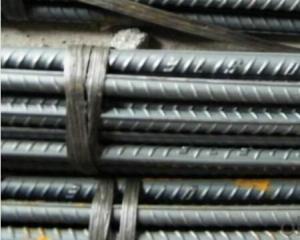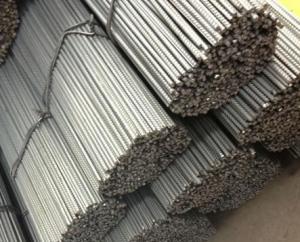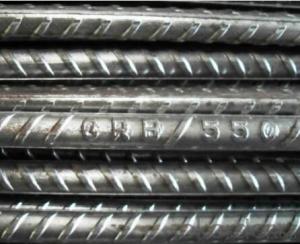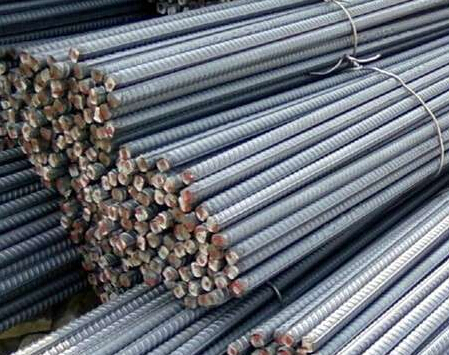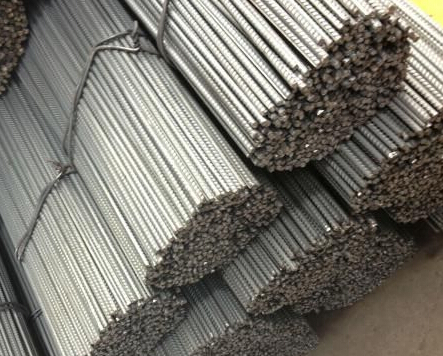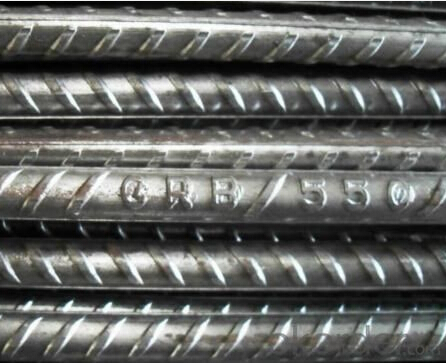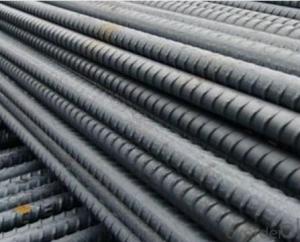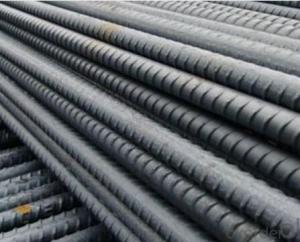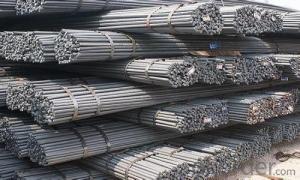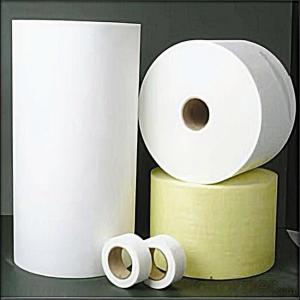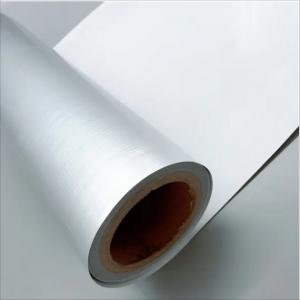Rebar for Sale - Deformed Steel Rebars with High-Quality and Standard GB, UK, USA
- Loading Port:
- China Main Port
- Payment Terms:
- TT or LC
- Min Order Qty:
- -
- Supply Capability:
- -
OKorder Service Pledge
OKorder Financial Service
You Might Also Like
Product Description:
OKorder is offering Deformed Steel Rebars with High-Quality and Standard GB,UK,USA with Standard GB,UK,USA at great prices with worldwide shipping. Our supplier is a world-class manufacturer of steel, with our products utilized the world over. OKorder annually supplies products to European, North American and Asian markets. We provide quotations within 24 hours of receiving an inquiry and guarantee competitive prices.
Product Applications:
Deformed Steel Rebars with High-Quality and Standard GB,UK,USA are ideal for structural applications and are widely used in the construction of buildings and bridges, and the manufacturing, petrochemical, and transportation industries.
Product Advantages:
OKorder's Deformed Steel Rebars with High-Quality and Standard GB,UK,USA are durable, strong, and resist corrosion.
Main Product Features:
· Premium quality
· Prompt delivery & seaworthy packing (30 days after receiving deposit)
· Corrosion resistance
· Can be recycled and reused
· Mill test certification
· Professional Service
· Competitive pricing
Specifications of High-Quality Deformed Steel Rebars with Standard GB,UK,USA:
Standard | GB UK USA | HRB335 HRB400 HRB500 G460B, B500A, B500B,B500C GR40, GR60 | |
Diameter | 6mm,8mm,10mm,12mm,14mm,16mm,18mm,20mm, 22mm,25mm,28mm,32mm,36mm,40mm,50mm | ||
Length | 6M, 9M,12M or as required | ||
Packing | Export standard packing: wrapped by wire rod in bundles | ||
Each bundle weight | 2-3MT, or as required | ||
Trade terms | FOB, CFR, CIF | ||
Payment terms | TT payment in advance or Irrevocable LC at sight. | ||
Delivery Detail | within 45 days after received advanced payment or LC. | ||
Brand name | DRAGON | ||
Theoretical weight and section area of each diameter as below for your information:
Diameter(mm) | Section area (mm²) | Mass(kg/m) | Weight of 12m (kg) | Pcs/ton |
6 | 28.27 | 0.222 | 2.664 | 375.38 |
8 | 50.27 | 0.395 | 4.74 | 210.97 |
10 | 78.54 | 0.617 | 7.404 | 135.06 |
12 | 113.1 | 0.888 | 10.656 | 93.84 |
14 | 153.9 | 1.21 | 14.52 | 68.87 |
16 | 201.1 | 1.58 | 18.96 | 52.74 |
18 | 254.5 | 2.00 | 24 | 41.67 |
20 | 314.2 | 2.47 | 29.64 | 33.74 |
22 | 380.1 | 2.98 | 35.76 | 27.96 |
25 | 490.9 | 3.85 | 46.2 | 21.65 |
28 | 615.8 | 4.83 | 57.96 | 17.25 |
32 | 804.2 | 6.31 | 75.72 | 13.21 |
36 | 1018 | 7.99 | 98.88 | 10.43 |
40 | 1257 | 9.87 | 118.44 | 8.44 |
50 | 1964 | 15.42 | 185.04 | 5.40 |
Chemical Composition: (Please kindly find our chemistry of our material based on JIS as below for your information)
JISG3112 SD390 | Chemical Composition | ||||
C | Mn | Si | S | P | |
0.22 | 1.38 | 0.4 | 0.014 | 0.022 | |
Physical capability | |||||
Yield Strength(N/cm²) | Tensile Strength(N/cm²) | Elongation (%) | |||
620 | ≥400 | 21 | |||
The production process of High-Quality Deformed Steel Rebars with Standard GB,UK,USA
1-Waling beam furnace 2-Roughing rolling group 3-Intermediate rolling train
4-Finishing rolling group 5-Water-cooling device 6-Walking beam cooler
7-Finishing equipment(including the cold scale shear,short feet collection system,
automatic counting device,bundling machine, collect bench)
Usage and Applications of High Quality Deformed Steel Rebars:
Deformed bar is widely used in buildings, bridges, roads and other engineering construction. Big to highways, railways, bridges, culverts, tunnels, public facilities such as flood control, dam, small to housing construction, beam, column, wall and the foundation of the plate, deformed bar is an integral structure material. With the development of world economy and the vigorous development of infrastructure construction, real estate, the demand for deformed bar will be larger and larger..
Packaging & Delivery of High Quality Deformed Steel Rebars:
Packaging Detail: products are packed in bundle and then shipped by container or bulk vessel, deformed bar is usually naked strapping delivery, when storing, please pay attention to moisture proof. The performance of rust will produce adverse effect.
Price: Keep lower operating costs so as to offer competitive price for our clients
Note:
1. Our products are produced according to national standard (GB), if not, supply according to national standards (GB) or agreement as customer required.
2. Other Grade and Standard Deformed Steel Bar we can supply:
Grade: GR40/GR60, G460B/B500A/B500B/B500C,BST500S
Standard: ASTM, BS, DIN
The Minimum Order Quantity of these products is high, and need to be confirmed.
3. We can not only supply Deformed Steel Bar; if you need anything about building materials, please contact us for further information.
4. Please send us your detail specifications when inquire. We will reply to you as soon as possible. We sincerely hope we can establish a long stable business relationship.
FAQ:
Q1: Why buy Materials & Equipment from OKorder.com?
A1: All products offered byOKorder.com are carefully selected from China's most reliable manufacturing enterprises. Through its ISO certifications, OKorder.com adheres to the highest standards and a commitment to supply chain safety and customer satisfaction.
Q2: How do we guarantee the quality of our products?
A2: We have established an advanced quality management system which conducts strict quality tests at every step, from raw materials to the final product. At the same time, we provide extensive follow-up service assurances as required.
Q3: How soon can we receive the product after purchase?
A3: Within three days of placing an order, we will begin production. The specific shipping date is dependent upon international and government factors, but is typically 7 to 10 workdays.
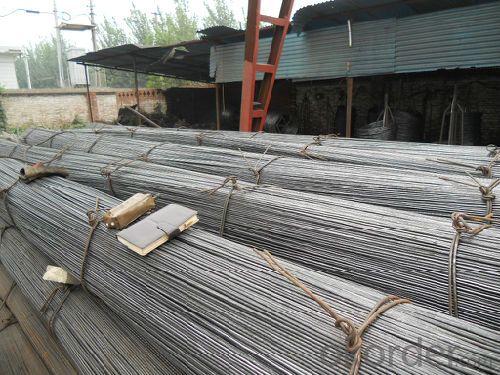
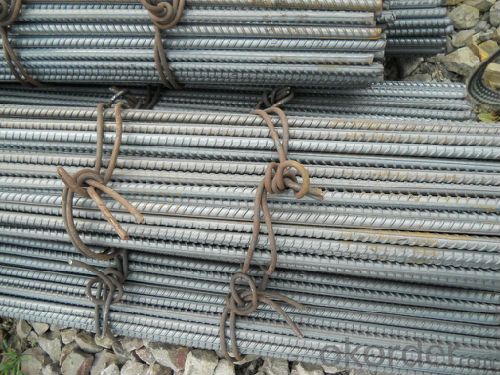
- Q:Can steel rebars be used in structures with high carbonation levels in concrete?
- No, steel rebars should not be used in structures with high carbonation levels in concrete. Carbonation is a chemical process that occurs when carbon dioxide reacts with the alkaline components in concrete. It leads to a reduction in the alkalinity of the concrete, which can cause the passive layer protecting the steel rebars to dissolve. This exposes the steel to corrosion, which can weaken the structure over time. To mitigate the risk of corrosion, it is recommended to use alternative materials, such as stainless steel rebars, in structures with high carbonation levels. Stainless steel rebars have a higher resistance to corrosion than carbon steel rebars and can withstand the harsh environment created by high carbonation levels in concrete. Additionally, other corrosion protection measures, like epoxy coating or concrete cover thickness, should also be considered to further enhance the durability and longevity of the structure.
- Q:How are steel rebars used in the construction of airports?
- To ensure the overall strength and stability of various concrete structures in airport construction, steel rebars are extensively utilized. These rebars, also known as reinforcing bars, are typically made of steel and are strategically placed within concrete elements like beams, columns, slabs, and foundations. In the context of airport construction, rebars primarily serve to reinforce the concrete used in runways, taxiways, and aprons. Runways, subjected to heavy loads and constant aircraft movements, require significant reinforcement to withstand immense pressure and prevent cracking or structural failure. By embedding steel rebars within the concrete, its tensile strength is enhanced, enabling it to bear heavy loads without compromising the runway's integrity. Similarly, taxiways and aprons, which accommodate aircraft taxiing, parking, and refueling, also rely on steel rebars for reinforcement. These areas experience continuous vehicle and equipment traffic, making them susceptible to wear and tear. By incorporating rebars in the concrete, these surfaces can endure constant stress and weight, ensuring durability and longevity. Apart from runways, taxiways, and aprons, steel rebars are also utilized in constructing other airport structures such as terminal buildings, control towers, hangars, and parking facilities. These structures necessitate strong foundations and sturdy frames to support the building's weight and withstand environmental factors like wind and seismic forces. Steel rebars are employed to reinforce the concrete foundations, columns, and beams, providing the necessary strength and stability. Overall, steel rebars play a vital role in airport construction by enhancing the structural integrity and durability of various concrete elements. They ensure airport facilities can endure heavy loads, constant traffic, and adverse weather conditions associated with air travel, guaranteeing the safety and efficiency of airport operations.
- Q:How do steel rebars improve the ductility of a structure?
- Steel rebars improve the ductility of a structure by providing reinforcement and enhancing its ability to withstand tensile forces. The presence of rebars within concrete or other structural materials allows them to better absorb and distribute stress, preventing brittle failure and promoting flexural strength.
- Q:Can steel rebars be used in the construction of offshore oil and gas platforms?
- Yes, steel rebars can be used in the construction of offshore oil and gas platforms. Steel rebars are commonly used as reinforcement in concrete structures and can provide the necessary strength and durability required for offshore platforms.
- Q:How do steel rebars resist corrosion?
- Passivation is the process by which steel rebars resist corrosion. When exposed to air and moisture, a thin layer of iron oxide is formed on the surface of the steel. This layer, commonly known as rust, acts as a protective barrier, preventing oxygen and moisture from reaching the inner layers of steel and halting further oxidation. To provide an additional layer of protection against corrosion, steel rebars are often coated with materials like epoxy or zinc. These coatings create a physical barrier, shielding the steel from the corrosive elements of the environment. Regular maintenance, which includes cleaning and applying protective coatings, can also contribute to prolonging the lifespan of steel rebars and preventing corrosion.
- Q:What is the role of steel rebars in the construction of water storage tanks?
- The role of steel rebars in the construction of water storage tanks is to provide structural reinforcement and enhance the overall strength and durability of the tank. The rebars, which are typically made of high-strength steel, are embedded within the concrete walls or floors of the tank to counteract tensile forces and prevent cracking or deformation. This reinforcement ensures that the tank can withstand the weight of the stored water, external pressures, and potential seismic activity, ensuring the long-term integrity and safety of the structure.
- Q:How are steel rebars connected or joined together during construction?
- Steel rebars are typically connected or joined together during construction using a variety of methods and techniques. The most common method is by overlapping the rebars and tying them together using steel wire. This process is known as rebar tying or wire tying. To ensure a strong and secure connection, the rebars are overlapped at a certain length, typically between 40 to 60 times the diameter of the rebars. The overlapping length allows for the transfer of load and ensures structural integrity. Once the rebars are properly overlapped, steel wire is tightly wrapped around the intersection point to hold them together. Another method of connecting rebars is by using mechanical couplers. Mechanical couplers are pre-fabricated devices that are used to join two rebars together. These couplers provide a threaded connection, allowing for a more precise and efficient joining process. The rebars are inserted into the couplers, and then the couplers are tightened using a wrench or other appropriate tool. Welding is also used to connect rebars, especially in larger construction projects. Welding involves melting the rebars at the intersection point and fusing them together using heat and pressure. This method provides a strong and permanent connection, but it requires skilled labor and proper safety precautions to ensure the quality of the weld. Furthermore, in some cases, rebars can be connected using epoxy bonding. Epoxy bonding involves applying an adhesive material to the surface of the rebars and then pressing them together. The epoxy acts as a bonding agent, creating a strong and durable connection between the rebars. The method of connecting rebars during construction depends on various factors such as the size of the rebars, the specific requirements of the project, and the construction techniques being used. It is essential to follow industry standards and guidelines to ensure the proper connection and integrity of the rebars, as they play a critical role in reinforcing concrete structures.
- Q:How do steel rebars affect the constructability of complex architectural designs?
- Complex architectural designs heavily rely on steel rebars to ensure their constructability. These reinforced bars are indispensable in providing structural integrity and strength to concrete elements, allowing for the creation of intricate and innovative designs. To begin with, steel rebars enable architects to design structures with larger spans and heights by offering the necessary load-bearing capacity. This is particularly crucial in complex designs involving cantilevers, soaring roofs, or suspended floors, as the rebars evenly distribute the loads, preventing any risk of structural failure. Furthermore, steel rebars enhance the constructability of complex architectural designs by facilitating the construction of slender and lightweight structures. Their strength and durability make it possible to reinforce thin concrete elements, effectively reducing the overall weight of the structure. This not only enhances the aesthetic appeal of the design but also leads to cost savings during the construction phase thanks to the reduced material requirements. In addition, steel rebars provide flexibility during the construction process. They can be easily bent and shaped to match the intricate geometries and curves of complex architectural designs. This allows architects to bring their creative vision to life by incorporating unique and eye-catching elements into the structure. Moreover, steel rebars significantly contribute to the durability and longevity of complex architectural designs. By reinforcing the concrete, they enhance its resistance to cracking, bending, and corrosion. This becomes particularly important in areas prone to seismic activity or harsh weather conditions, as the use of rebars ensures that the structure can withstand these challenges and remain intact over time. Overall, the impact of steel rebars on the constructability of complex architectural designs cannot be overstated. Their strength, versatility, and ability to reinforce concrete elements make it possible to create structures that are not only visually appealing but also structurally sound. Without the support of steel rebars, the construction of such complex designs would be considerably more challenging, if not outright impossible.
- Q:How are steel rebars protected against corrosion in aggressive environments?
- Steel rebars are protected against corrosion in aggressive environments by using various methods such as epoxy coatings, zinc coatings, and cathodic protection. These measures create a barrier between the rebar and the corrosive elements, preventing the steel from coming into direct contact with moisture and oxygen. Additionally, proper concrete cover and pH control in the surrounding environment can also contribute to the protection of steel rebars against corrosion.
- Q:Can steel rebars be used in renovation or retrofitting projects?
- Yes, steel rebars can be used in renovation or retrofitting projects. Steel rebars are commonly used in construction projects to reinforce concrete structures, providing strength and durability. In renovation or retrofitting projects, where existing structures need to be strengthened or modified, steel rebars can be utilized to enhance the structural integrity and ensure the safety of the building.
1. Manufacturer Overview |
|
|---|---|
| Location | |
| Year Established | |
| Annual Output Value | |
| Main Markets | |
| Company Certifications | |
2. Manufacturer Certificates |
|
|---|---|
| a) Certification Name | |
| Range | |
| Reference | |
| Validity Period | |
3. Manufacturer Capability |
|
|---|---|
| a)Trade Capacity | |
| Nearest Port | |
| Export Percentage | |
| No.of Employees in Trade Department | |
| Language Spoken: | |
| b)Factory Information | |
| Factory Size: | |
| No. of Production Lines | |
| Contract Manufacturing | |
| Product Price Range | |
Send your message to us
Rebar for Sale - Deformed Steel Rebars with High-Quality and Standard GB, UK, USA
- Loading Port:
- China Main Port
- Payment Terms:
- TT or LC
- Min Order Qty:
- -
- Supply Capability:
- -
OKorder Service Pledge
OKorder Financial Service
Similar products
New products
Hot products
Hot Searches
Related keywords

